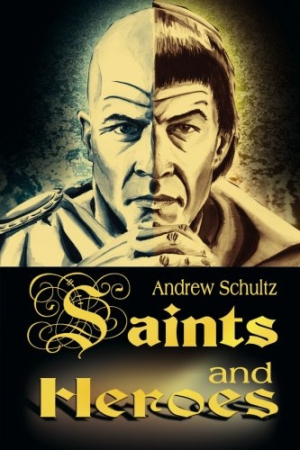Saints and Heroes
Shakespeare’s MacBeth and the character who slew him, Malcolm, were based on real people. In his novel Saints and Heroes, Andrew Schultz brings his king slayer to life in a far less heroic but much more accurate manner than Shakepeare does in his play. Schultz tells this tale through the eyes of Malcolm’s lifelong companion, Anselm, a priest who is no more saint than Malcolm is hero, and therein lies the true joy of this book.
Anselm and Malcolm are depicted as flawed, although the former at least knows he suffers from human failings, while the latter, a spoiled royal bully with a mean temper, does not. How these two grow during the tumultuous events of eleventh-century Scotland is as much a tale of two men as it is a story of the creation of a kingdom. Issues of church and state, disputes of faith and crown, and matters of life and death are all woven into this story in a believable, human, and, at times, humorous manner.
Schultz does not break new ground in this genre, but he does plow and plant it well. His characters feel and act real, they sometimes give in to temptation, feel guilt, and face the consequences of their actions. Things don’t always turn out well for the saint or the hero, which in itself is not only realistic but also refreshing to see in a novel.
Schultz’s depictions of life in the period are as accurate as they are vivid. In some passages, the reader can almost smell the stench, feel the filth, and sense the gloom of living with people who “search their beards and hair after dining, ferreting out the bits of the meal that were worth finishing off, and snapping the fleas and lice they found between their fingernails.”
Saints and Heroes suffers from a slow start as it focuses on the boyhood of Anselm and the adolescence of Malcolm, but those sections set the stage for a much more riveting adventure story that climaxes about two-thirds into the book. The final third is more of a history of how Malcolm and his venerated queen, Margaret, brought the Scots together into a single kingdom united around the castle they built on the great rock of Edinburgh.
Although the books contains a few minor inaccuracies (the Saxons Tostig and Harold Godwinson did not have mounted knights in their retinue) and minor typos (a dropped vowel here, a spacing error there), it is a masterfully written and well-researched tale.
Schultz includes a four-page bibliography of his sources, which include both standard histories and esoteric studies such as The Medieval Cookbook, Celtic Monasticism, and Sex in History. That he read these three works is evident in his descriptions of the local diet, religious way of life, and human interactions of an amorous or at least physical nature. There is also a good bit of bashing about with swords and other adventures to keep the story moving and the reader turning pages.
Reviewed by
Mark McLaughlin
Disclosure: This article is not an endorsement, but a review. The publisher of this book provided free copies of the book and paid a small fee to have their book reviewed by a professional reviewer. Foreword Reviews and Clarion Reviews make no guarantee that the publisher will receive a positive review. Foreword Magazine, Inc. is disclosing this in accordance with the Federal Trade Commission’s 16 CFR, Part 255.

